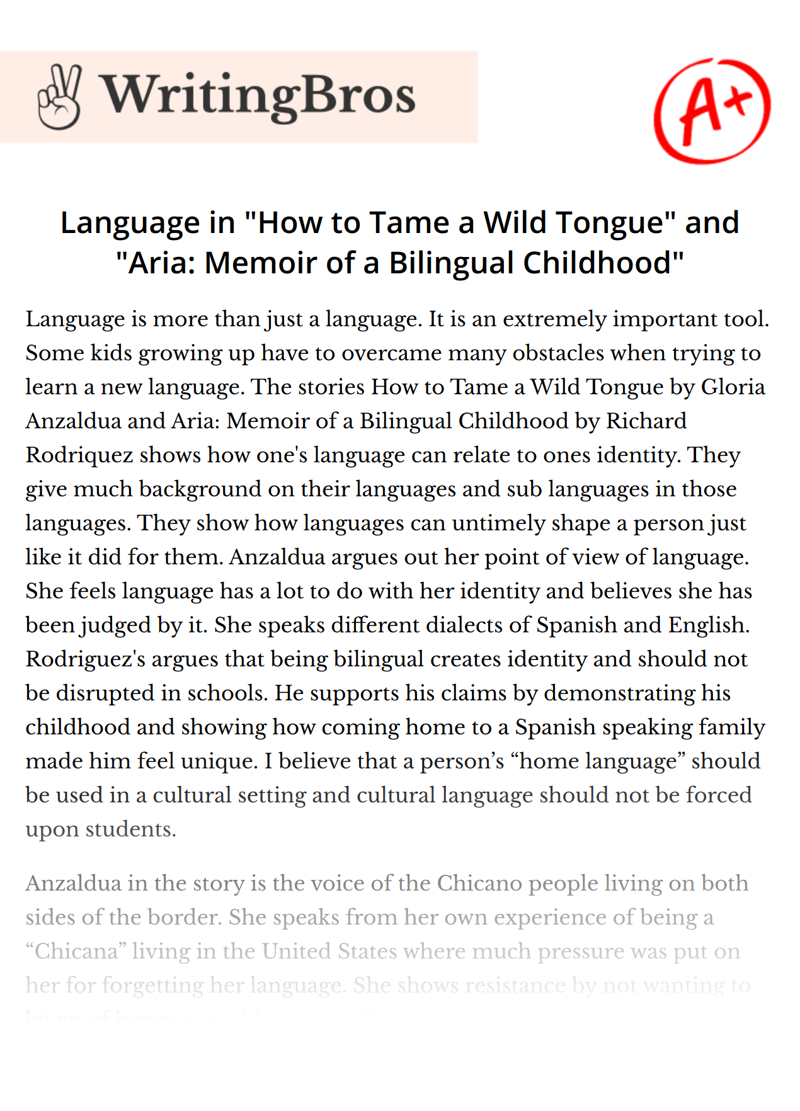Language in "How to Tame a Wild Tongue" and "Aria: Memoir of a Bilingual Childhood"

Language is more than just a language. It is an extremely important tool. Some kids growing up have to overcame many obstacles when trying to learn a new language. The stories How to Tame a Wild Tongue by Gloria Anzaldua and Aria: Memoir of a Bilingual Childhood by Richard Rodriquez shows how one's language can relate to ones identity. They give much background on their languages and sub languages in those languages. They show how languages can untimely shape a person just like it did for them. Anzaldua argues out her point of view of language. She feels language has a lot to do with her identity and believes she has been judged by it. She speaks different dialects of Spanish and English. Rodriguez's argues that being bilingual creates identity and should not be disrupted in schools. He supports his claims by demonstrating his childhood and showing how coming home to a Spanish speaking family made him feel unique. I believe that a person’s “home language” should be used in a cultural setting and cultural language should not be forced upon students.
Anzaldua in the story is the voice of the Chicano people living on both sides of the border. She speaks from her own experience of being a “Chicana” living in the United States where much pressure was put on her for forgetting her language. She shows resistance by not wanting to let go of her maternal language. She is proving that there is no point in changing one’s language by switching back and forth between Spanish and English. When a teacher would catch her speaking Spanish at school she would be punished by that teacher. Anzaldua says, “I remember being caught speaking Spanish at recess that was good for three licks on the knuckles with a sharp ruler” (34). Here she was accused of talking back to a teacher when all she actually was doing, was giving an explanation. Anzaldua argues how importantant it is to keep your home language in an acedmeic setting. Her argument is very convincing since she experienced it first hand.
Rodriquez argues that schools who try to teach children in their home language will take away from their learning. He argues that their home language is something those kids value and the value would decrease because it starts to become a 'public' language. Spanish to him was only dedicated to people he trusted and was close to. He also claims that trying to translate Spanish to English and vice versa would demonstrate the actual meaning behind the words. The only thing that would be demonstrated is the literal meaning. Rodriquez says, “I knew I had turned to English with angry reluctance. But once I spoke English with ease, I came to feel guilty. I sensed that I had broken the spell of intimacy which had once held the family so close together (292).” At first he felt guilty because he was no longer able to speak his home language, but he soon realized that speaking two languages is what made him unique. Although, he can no longer converse in Spanish, he is okay knowing that he has an ability his classmates don't. Rodriguez establishes a connection with the audience through his personal experience as a child to convey his point of view of home language being used in an acedemic setting.
Although I believe it's essential for an individual to know more than one language, I also believe that students shouldn’t be forced to learn in a cutural language. This can cause a family to lose its culture. In society’s where a specific language is the main language, a person should be educated in that language. Therefore, they can speak with others and participate on a day to day basis, but it doesn't have to be mandatory. However, teaching languages in school should still be put in place. Anzaldua believes home language should be used in an acedemic setting and rodriquez disagrees and believes it should not be used. Both of them have first hand experiences of the situations, so both of their points are valid.
Cite this Essay
To export a reference to this article please select a referencing style below

